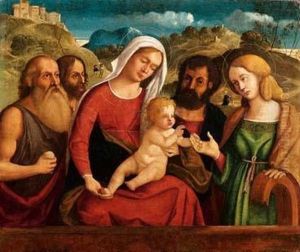Francesco Di Gerolamo Da Santa Croce Paintings
Francesco di Gerolamo da Santa Croce, also known as Francesco da Santa Croce or Francesco da Santacroce, was an Italian painter of the Renaissance period who was active primarily in the region of Bergamo. His exact birth and death dates are not well-documented, but he is generally believed to have been born around 1485 and to have died in 1556. Francesco was part of the Santa Croce family of painters, which included his brother Bernardino and his father Jacopo. The Santa Croce family workshop was well known in Bergamo and the surrounding areas for their contributions to the painting of altarpieces and religious frescoes.
Francesco’s style was influenced by the Venetian Renaissance, which was characterized by its use of vibrant colors and attention to detail, as well as a focus on the effects of light. His work, however, also shows the influence of the Lombard painting tradition, known for its more sober and less ornate approach. This combination of influences allowed Francesco to develop a style that was both rich in color and deeply expressive.
Very little is known about Francesco’s life and training. It is assumed that he trained under the guidance of his father and later worked alongside his brother. The works attributed to Francesco often show a strong narrative quality and a skillful use of color and composition that suggest a high level of craftsmanship and artistry. His paintings were mainly religious in nature, reflecting the predominant themes of the period, with works such as 'Madonna and Child with Saints' and 'The Crucifixion' among those attributed to him.
Despite the fact that Francesco da Santa Croce was an accomplished painter of his time, his fame has been overshadowed by the more prominent artists of the Venetian Renaissance, such as Titian and Tintoretto. Consequently, much of his life and work remain less studied, and many pieces that might have been attributed to him have been lost or remain unrecognized.
Francesco da Santa Croce’s contributions to the art world may not be as well known as those of his contemporaries, but his works still offer valuable insights into the regional variations of Renaissance painting in Italy. His legacy continues to be appreciated by those who study the nuanced developments of Renaissance art outside of the major artistic centers of Florence, Rome, and Venice.
